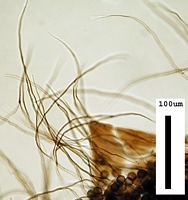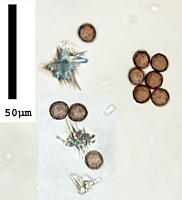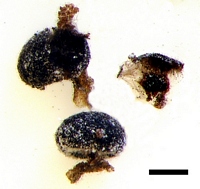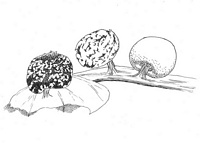|
 Didymium melanospermum Didymium melanospermum
SynonymsDidymium farinaceum
Physarum melanospermum
BiostatusPresent in region - Indigenous. Non endemic
Images (click to enlarge)
Caption: peridium and capillitium.
Owner: J.A. Cooper | 
Caption: spores and stellate crystals
Owner: J.A. Cooper | 
Caption: fruitbodies. Right = peridium and capillitial threads. Scale = 0.5mm.
Owner: J.A. Cooper | 
Caption: Three sporangia of Didymium melanospermum, each of which is about 1 mm tall. The umbilicate base of the sporotheca is visible for the sporangium on the right.
Owner: S.L. Stephenson | |
Article: Stephenson, S.L. (2003). Myxomycetes of New Zealand. Fungi of New Zealand. Ngā Harore o Aotearoa 3: xiv + 238 p. Hong Kong: Fungal Diversity Press.
Description: Fruiting body a stalked (or sometimes sessile) sporangium, gregarious, up to 1 mm tall. Sporotheca subglobose or depressed, deeply umbilicate below, white or grey, 0.5–1.0 mm in diameter. Peridium firm, dull brown or black, more or less densely covered with white lime crystals. Stalk usually short, stout, rarely up to two-thirds the total height, dull brown or black, often completely immersed in the umbilicate base of the sporotheca. Columella prominent, hemispherical, dark or pallid, calcareous. Capillitium consisting of sparingly branched, pale to purple-brown, sinuous threads, these varying from slender to robust, often bearing dark, nodular thickenings. Spores black in mass, dull purplish brown by transmitted light, strongly warted or spiny, 10–14 µm in diameter. Plasmodium colourless or dull grey.
Habitat: Decaying wood, twigs, and dead leaves
Distribution: Considered to be cosmopolitan by Martin & Alexopoulos (1969) and sometimes abundant in the tropics. First reported (as D. farinaceum) from New Zealand by Lister & Lister (1905), based on specimens from South Canterbury and Stewart Island. Also known from Auckland, Coromandel, Fiordland, and Mackenzie.
Notes: The distinguishing characteristics of this species are the robust, deeply umbilicate sporotheca and the short dark stalk. It sometimes occurs in the same types of ecological situations as Didymium squamulosum. However, the sporotheca of D. squamulosum is globose to discoid and the stalk is white
|